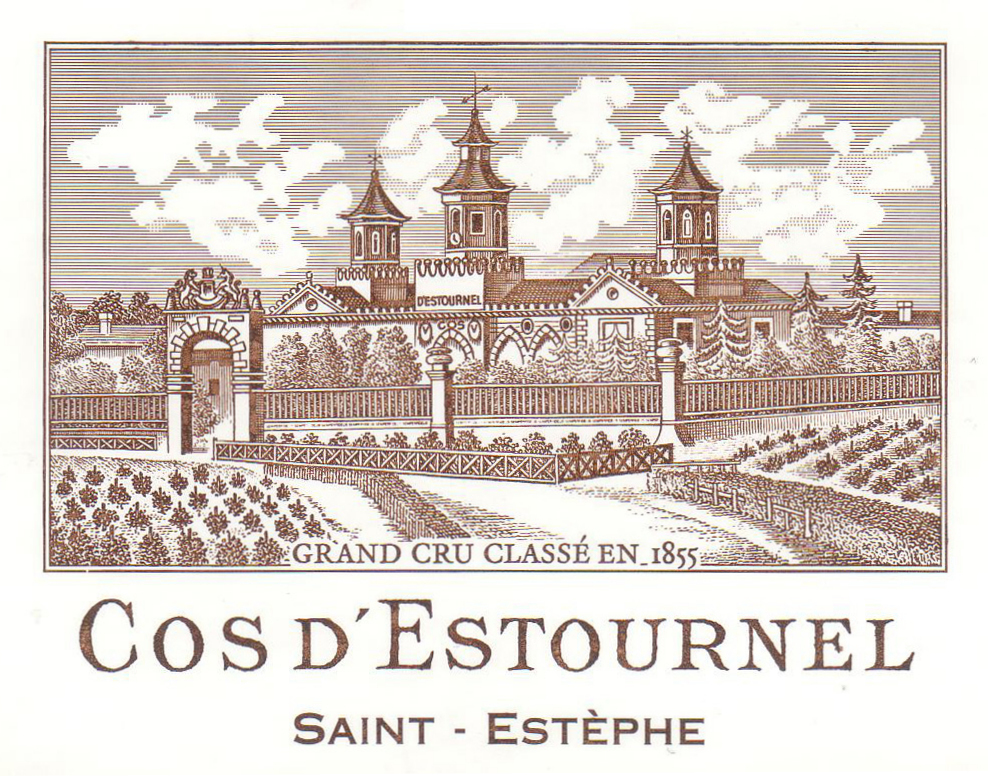Château Cos D'Estournel 1993
Review of the Estate
Château Cos d'Estournel is a winery in the Saint-Estèphe appellation of the Bordeaux region of France. It is also the name of the red wine produced by this property. The wine produced here was classified as one of fifteen Deuxièmes Crus (Second Growths) in the original Bordeaux Wine Official Classification of 1855.
Château Cos d'Estournel produces the eponymous grand vin, the second wine since the 1994 vintage, Les Pagodes de Cos from the estate's younger vines, as well as Château Marbuzet from fruit of nearby plots. The property is adjacent to Château Lafite-Rothschild in the neighbouring commune of Pauillac.
In 1811, Louis Gaspard d'Estournel decided to make wine from a few hectares of vines that he had inherited and Château Cos d'Estournel was born. Classified as a Deuxième Cru Classè in 1855, exports of this prestigious wine eventually reached as far as Southeast Asia, which inspired long-time Sinophile Louis to erect the unique and recognisable stone pagodas which still stand over the estate's cellars. Unfortunately, due to surmounting debts, Louis Gaspard eventually had to sell Chateau Cos Destournel, but his name has endured to this day.
During subsequent decades the estate underwent several ownership changes. However, the most significant improvements to the property were made during the tenure of Bruno Prats, who headed the estate from the late 1980's through to 1998. Along with his son (and current estate manager) Jean-Guillaume, Bruno modernised and improved both the facilities and winemaking practices.
In the old Gascon language of the region, Cos means 'hill of pebbles' and this accurately describes the soil composition of the estate's vineyards - deep gravel over a limestone bed.
The vineyards at Chateua Cos D'Estournel are worked manually and the harvest is always done by hand. Only vines that are more than 20 years old are used for the Grand Vin, while vines which are younger are used for the estate's second wine - Les Pagodes de Cos.
The château cellars were refurbished in 2009 and are now some of the most modern in Bordeaux - a feat of beautiful glass and steel engineering. Fermentation takes place in stainless steel, temperature controlled tanks and both pump-overs and racking are done by gravity. Malolactic fermentation takes place in barrel, of which 60 to 100% are new French oak. Chateau Cos D'Estorunel Grand Vin is aged for 18 months in barrel before bottling, while Les Pagodes de Cos is aged for 12 months.

Vineyard
Surface area: 158 acres
Grape Varieties: 60% Cabernet Sauvignon, 38% Merlot and 2% Cabernet Franc
Average age of vines: 35 years
Density of plantation: 8,000 - 10,000 vines per hectare
Average yields: 50 hectoliters per hectare
Average cases produced: 20,000 per year
Plateau of maturity: 10-30 years
Château Cos d'Estournel 1993 Reviews / Tasting Notes
Robert Parker - The Wine Advocate
Point Score: 89
A word of admiration and praise is in order for Bruno Prats. One of St.-Estephe's most forward thinking producers, Prats is never content with merely making outstanding wine. Over the last few years he has improved Cos d'Estournel, already one of the great wines of Bordeaux, by eliminating any filtration at bottling, and replacing the standard paper label with one made of plastic so it will not disintegrate in damp, humid cellars. Additionally, the quality of his wines in such difficult vintages as 1992 and 1993 has been remarkable. Readers should also note that a second wine, the beautifully packaged Les Pagodes de Cos, has been implemented with the 1994 vintage. It appears to be a fine second wine. One of the most successful Medocs of the vintage, Cos d'Estournel's 1993 exhibits an opaque dark purple color, and a heady, sweet, pure, blackcurrant bouquet that roars from the glass. With surprising richness, fat, and glycerin, tasters would never suspect that this medium-bodied, elegant yet authoritatively-flavored wine emerged from such a difficult vintage. The wine's low acidity and roundness guarantees 12-14 years of drinkability. This is a splendid success in an irregular vintage. Cos d'Estournel is clearly producing wines that are often of first-growth potential.
Wine Spectator
Point Score: 88
Impressive for the vintage, displaying a wonderful silky texture and plenty of blackberry and tobacco character. Drinkable now.